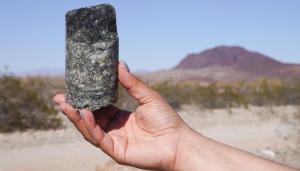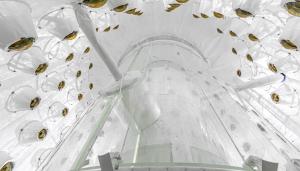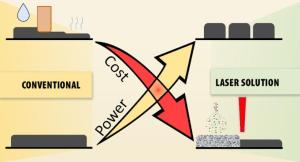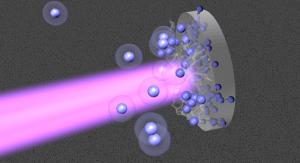LAB REPORT
Science and Technology Making Headlines
July 15, 2022


Rare earths bearing core sample drilled at La Paz, Arizona. Image courtesy of American Rare Earths Ltd/ photographer Dane Rhys.
Mother Nature’s purifier
Using naturally occurring and engineered proteins and bacteria, Lawrence Livermore scientists and collaborators will separate and purify rare-earth elements so they can be used in the defense sector.
Under the Defense Advanced Research Projects Agency (DARPA) Environmental Microbes as a BioEngineering Resource (EMBER) program, the team was awarded an initial $4 million in funding R&D in Phase 1 with an option for up to an additional $9 million based on program performance in follow-on phases. The team will leverage advances in microbial and biomolecular engineering to develop a scalable bio-based separation and purification strategy for rare-earth elements (REEs) using under-developed domestic sources. REES are a set of 17 elements in the periodic table including the 15 lanthanides plus scandium and yttrium.
REEs are essential for American competitiveness in a high-tech economy because they are used in many devices important to the clean energy industry and national security, including computer components, wind turbines, hybrid/electric vehicles, LCD screens and tunable microwave resonators. In the defense sector, they are used for lasers, precision-guided weapons, magnets for motors and other devices.


Soil and associated organic molecules are crucial to agriculture, healthy ecosystems and the planet’s climate. LLNL researchers study this process in the new Soil Microbiome Scientific Focus Area initiative. Credit: blueenayim/iStock.
Microbes to the rescue
Diverse microbes are the key to healthy soil. How will a warming planet affect them, and what can farmers do to mitigate some of those changes?
Soil is teeming with billions of microscopic organisms that comprise the most biodiverse environment on Earth. Like all living things, they’re affected by climate change, too. But microbes tend to be adaptable.
Jennifer Pett-Ridge, a senior staff scientist studying soil microbial ecology at Lawrence Livermore, said. “Each microorganism has a bag of tricks…it’s hard wired to carry out — a defined functional trait space. So here’s one organism that can handle [low oxygen] when it’s flooded, or another that can handle low water potential." As long as there’s a wide range of microbes in the soil, some of them will thrive under new conditions.
Despite all of the uncertainty about how soil microorganisms will respond to climate change, there actually is an easy answer to growers who might be worried about it: aim for soil populated by a diverse group of microbes.

Looking up into the LZ Outer Detector, used to veto radioactivity that can mimic a dark matter signal. Credit: Matthew Kapust/Sanford Underground Research Facility.
LUX gets a first look at dark matter
Deep below the Black Hills of South Dakota in the Sanford Underground Research Facility (SURF), an innovative and uniquely sensitive dark matter detector — the LUX-ZEPLIN (LZ) experiment — has passed a check-out phase of startup operations and delivered its first results.
In a paper posted on the experiment’s website, researchers report that with the initial run, LZ is already the world’s most-sensitive dark matter detector.
Lawrence Livermore National Laboratory (LLNL) has a long history of contributions to LZ and the preceding LUX experiment, including significant roles in LUX construction, operation and analysis. The success of LUX played a large part in motivating the step up to the larger, more sensitive LZ experiment.
“This is a great result, but only the first step for LZ. We anticipate a lot more exciting dark matter results in the coming years. The various synergetic R&D activities at LLNL will help expand LZ’s dark matter searches,” said LLNL physicist Jingke Xu, who oversaw LUX analyses and publications for three years.


Compared with conventional slurry-based film electrode manufacturing methods, dry laser powder bed fusion is promising in generating structured electrodes for high power, low cost lithium ion batteries. Image by Jianchao Ye/LLNL.
Li batteries go 3D
Lawrence Livermore National Laboratory (LLNL) has partnered with battery material specialist Ampcera to develop the next generation of lithium battery cathodes using 3D printing technology.
The project is backed by $1.5 million from the Advanced Manufacturing Office at the U.S. Department of Energy, and will see the research partners leverage solvent-free Laser Powder Bed Fusion processes. The aim of the work is to create unique 3D battery structures capable of faster charging and higher energy densities, all while slashing manufacturing costs and lowering energy consumption.
According to LLNL, today’s widely used battery manufacturing techniques, which are based on slurry casting and coating, are struggling to advance the aforementioned metrics. These approaches utilize energy-intensive processes, as well as rely on dangerous solvents as raw materials for electrodes. Additionally, they’re based on specialized production lines that can only manufacture one type of battery at a time, meaning there’s no design flexibility when it comes to battery geometry.


Laser-driven shock waves reaching several million atmospheres break the extremely strong triple-bond of nitrogen molecules and free up a fraction of the L-shell electrons of the dissociated atoms. Image by Liam Krauss/LLNL.
Breaking nature’s strongest chemical bonds
Some chemical bonds can be really permanent. A way has been found to disassemble it, which may be useful not just in chemistry.
In the exact sciences, the formation of new chemical bonds is more desirable than the breaking of existing ones. But not always. Decay reactions are important in the context of our understanding of the laws of nature. Scientists at Lawrence Livermore (LLNL) obtained very accurate data on the behavior of dense nitrogen under extreme conditions, which could contribute to a better understanding of the interior of exoplanets and white dwarfs.
Molecular nitrogen (N2) is about 78% of the air we breathe. Two nitrogen atoms are linked by a triple covalent bond, the strongest of which is found in simple diatomic molecules. Nitrogen also is a major component of celestial bodies in the outer solar system and beyond. Astronomers believe that ammonia storms (NH3) occur on giant planets such as Jupiter, while the dwarf planet Pluto, the icy moon of Saturn Titan and the icy moon of Neptune, Triton, have nitrogen-rich atmospheres.2.
LLNL researchers conducted shock experiments on pre-pressed molecular nitrogen liquid at pressures up to 800 gigapascals. They observed clear signs of complete molecular dissociation near 70-100 GPa and 5-10 kK and the onset of ionization of the outer electrons above 400 GPa and 50 kK.





